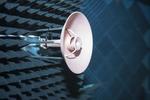
OLO, the company based in the US has come up with a 3D printer that can print 3D objects on the go, with a smartphone. They started their campaign on Kickstarter and they have already got $933,800 of the $80,000 for what they pledged.

Physicists have unveiled a programmable five-qubit processing module that can be connected together to form a powerful quantum computer.

Holoportation is now a thing, so start slapping everyone in arm's distance to make sure they're real.
Amazing 7D Hologram Technology in Japan

New research by engineers has demonstrated how a massive antenna system can offer a 12-fold increase in spectrum efficiency compared with current 4G cellular technology.

Here it is, folks, our first glimpse of the fully constructed Airlander 10. This floating behemoth measures 302-feet-long, which is 60 feet longer than a jumbo jet.

A few years ago, researchers from Germany and Japan were able to simulate one percent of human brain activity for a single second. It took the processing power of one of the world’s most powerful supercomputers to make that happen.

The supercomputer can be compared to the western cowboys that tamed wild horses, also called Wranglers, because the computer is capable of taming big data.

The town has entered into its technologically advanced and innovative stage brought on by the introduction of the broadband wireless internet service with speeds of up to 1 Gb/s

It is believed the breakthrough could lead to ultra-fast communication between computer chips and electronic systems and therefore transform a wide variety of sectors, from communications and healthcare to energy generation.

Are robots coming for your job? It's not an unreasonable question. Just last week, President Barack Obama warned congress that robots are going to begin taking over jobs that pay less than $20 an hour, placing 62% of American jobs at risk.

The European Space Agency and SWISSto12 have developed a prototype dual reflector antenna that was 3D printed in a single piece.

Actiongram lets you create augmented reality tales without a lick of visual effects experience.

A new class of miniature biological robots, or bio-bots, has seen the light -- and is following where the light shines. The bio-bots are powered by muscle cells that have been genetically engineered to respond to light, giving researchers control over the bots

As optical computing becomes a more realistic prospect, lasers will be required to connect components inside our devices. Now, a new silicon-based laser could make it far easier for researchers to replace wires with beams of light.